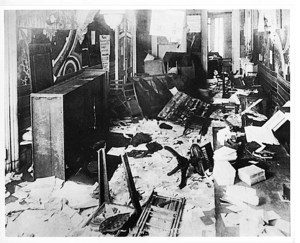On this day in 1920, in an attempt to rid America of its “moral perverts”, federal agents under the direction of U.S. Attorney General A. Mitchell Palmer raided without warrants pool halls, restaurants and private homes in thirty-five American cities. They arrested more than six thousand alleged radicals. Known as the Palmer Raids, the anniversary of this onslaught against civil liberties marks the height of a government campaign begun in 1919 to fight a perceived “red menace” that the ruling class believed to be a threat to “Americanism”.
World War I was over. America had been on the winning side, and yet it was gripped in fear. Suspicion and paranoia of Bolsheviks, Anarchists, feminists, labour militants and anyone with a foreign accent was rampant. A jury in Indiana took just two minutes to acquit the killer of an immigrant who had yelled “To Hell with the United States”. A salesman in Connecticut was sentenced to jail for six months for remarking to a customer that Lenin was “one of the brainiest” world leaders. And the Ku Klux Klan re-emerged with a deadly vengeance. It was in this milieu that, in November 1919, Attorney General Palmer ordered federal agents to raid the homes and headquarters of suspected radicals. This first-wave of raids received huge support from a xenophobic public fed lies that there was a great conspiracy led by “foreign radicals” aimed at overthrowing their American way of life. High-profile anarchists Emma Goldman and Alexander Berkman were shipped back to the Soviet Union, along with some 500 other undesirables, while the Industrial Workers of the World – the scourge of the government and industry bosses – was brutally targeted. “The nation owes a debt of gratitude to A. Mitchell Palmer,” the New York Herald editorialised. “And now let there be no mawkish sentimentality about these rascals, no prattling of the sacred right of free speech from parlour socialists and others of that ilk.”
Emboldened by the public’s approval, and hoping to ride the wave of his success all the way to the White House in the 1920 presidential election, Palmer leaked information to the press that a revolution was “imminent”. With the justification in place for stepping up his raids and arrests, the scene was set for the largest-ever federal dragnet. Those arrested on 2nd January 1920 were incarcerated in jails and detention centres for weeks and even months without the right to legal counsel or bail while they were interrogated and often beaten. In Detroit, “eight hundred men were packed in a narrow windowless corridor on the top floor of a federal building,” recalled a witness in Labor’s Untold Story. “They remained there, many ill and without food, for six full days … Then they were moved to a deserted army encampment at Fort Wayne where new methods of torture were devised. The wives and children of those imprisoned there were beaten in the sight of the prisoners.” Meanwhile, Congress actually debated imposing the death penalty for insurrection.
But when Palmer’s Justice Department attempted to change the law to deprive suspected radicals of their right to vote – the most sacred fundament on which the nation was founded – the backlash against such Draconian tactics and violations of civil liberties at last began. Assistant Labor Secretary Louis Post discovered that only forty of the several thousands arrested had actually admitted a desire to overthrow the U.S. government, and subsequently ordered the release of detainees and cancellation of deportations. Palmer responded by questioning Post’s patriotism. The Palmer Raids and associated hysteria finally simmered down when the “imminent revolution” failed to materialise on 1st May as per Palmer’s prediction; the government’s war on immigrants and civil liberties fell apart soon after.
The Palmer Raids marked the first time in America’s history when thousands were ethnically profiled and arrested as part of a criminal investigation without being charged of a crime. But it would not be the last. While Palmer’s federal flunkies were rounding up innocent immigrants, one particularly zealous agent was a 24-year-old anti-Communist by the name of J. Edgar Hoover. The lessons learned by Hoover in illegal domestic surveillance and detention, denying suspects their rights, infiltrating covert organisations and torturing progressive leaders, would serve him well for the next Red Scare.



3 Responses to 2nd January 1920 – The Palmer Raids